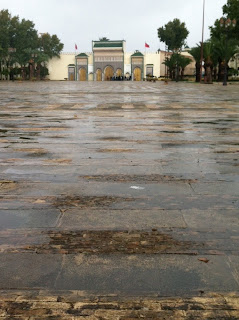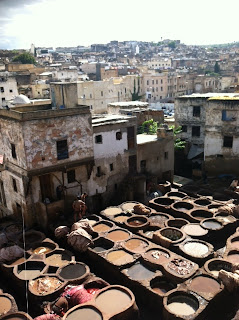My parents visited recently, and my whole perspective on
Morocco has changed since. All I needed was a little taste of home to remind me
of the amazing things I have in my life, and to free me up to enjoy my life
here.
I could go on all day about how thankful I am for my family,
for the comfort they bring me, for my sister with whom I have a relationship
incomparable to any other. I think all the time about how
thankful I am for friends, both old and new, and for all of the opportunities I
have to enjoy my life every day in Colorado, one of the most beautiful places
in the world.
But it’s not every Thanksgiving that I get to sit on the
roof of a ‘terrasse’ in Fes, Morocco, sipping spiced coffee and thinking of the
things I’m thankful for here, in this country. Allow me…
- I’m thankful for the narrow
streets in the old Medina that don’t accommodate cars, and allow only the
occasional moto to pass through, but more often give way to donkeys, horses,
and throngs of people on foot. These alleys and passages are what both confuse
visitors with a feeling of disorientation and empower residents who know their
secrets. They provide a neverending gameboard where players must dart right and
left to avoid oncoming traffic, and constantly question their choice of which
side of the street to walk on.
- I’m thankful for color.
There’s a western fashion “rule” that says one mustn’t wear white after Labor
Day or before Memorial Day. We extend that rule to include bright colors, which
tends to shift the mood on the street starting in September to “fall colors”:
burnt orange, deep purple, maroon, dark turquoise. Morocco doesn’t know about
this rule, and thank goodness. I love fall colors – they are some of my favorite.
But nothing can lift my spirits quite like an arrestingly bright yellow, crush velvet
djellaba on a rainy gray day in the old city.
| Minaret under construction |
- I’m thankful for Islam,
because despite my personal opinions about the religion, whatever they may be,
it imposes a sense of order and peace on daily life here unlike any other I’ve
lived in. The call to prayer, the respect for family time, even the caring
relationship with stray street cats: much of the heart of this country is shaped
by this religion, and Morocco wouldn’t be Morocco without it. I am even
thankful for the fact that Islam, and the traditionalism instilled by it, keeps
images of extreme capitalism and sexism away from the public eye. I love the
freedom of America, but I could do without being compared to, and forced to compare
myself to, every half naked woman on a billboard ad or artificially enhanced
beauty in a magazine.
- I’m thankful for souks
and hanoots: open air markets and miniature stores that sell everything
from Dannon yogurt and Pringles to nail clippers, band-aids and bulk flour. The
presence and proliferance of these small shops in the medina dictates that you
buy only what you need on a given day – there’s no need to stock up on a
lifetime’s supply of pasta. Tomorrow is another day, insha’allah – but live, and
shop, for today.
| Shoes! |
- I’m thankful for mint
tea, which I drink multiple times daily here. Not only is it delicious, but
it’s representative of a ritual that emphasizes the importance of patience,
interhuman relationships, respect and simplicity.
- I’m thankful for artisans
– Fes is full of them. They are the reason that the living room walls in my
very basic apartment home are as beautiful as any I’ve ever seen. They are the
reason the sun filters through three separate colors of stained glass in my
bedroom. They are the reason even the most mundane sights, a street packed with
djellaba and babouche clad locals, are infiltrated with extreme beauty.
- I am thankful for walls.
Some people think Old Fes has an eerie feeling, that it feels like a maze with
high walls and no obvious way out. But nothing surpasses the sensory overload
of stepping from the khaki colored, lack luster public street through a
discrete door into a beautiful riad chock full of colorful zellij, intricate
wood carving and calming water features. Sometimes it’s worth holding our cards
close because it allows us to appreciate true beauty that much more.
- I am thankful for cobblestone
streets, and the way my shoes sound walking through them. I wake up at 5 am
each morning to the sound of carts being pushed down the Talaa Kebira,
sometimes accompanied by rain drops falling on the stone – there’s no sound I
enjoy more here.
- I’m thankful for bread.
Atkin’s Dieters be warned – Morocco is not for you. Bread is a way of life
here, and it’s found in every form, from flakey, chocolate smeared malawi to the coral-like raised pattern
of baghrira. Bread, in all it’s
forms, is the lifeblood of Moroccan cuisine, and I would pray to it 5 times a
day if it were socially acceptable.
 |
| Rainy day at the Royal Palace |
- I’m thankful for rain,
because if you can’t leave it, love it. The downpour experiences I’ve had in
this city are only rivaled by one I nearly drowned in in Nashville, Tennessee
several years ago. They come unexpectedly and absolutely wipe out anything and
everything not anchored to the ground. They create rivers in the narrow alleys,
causing shop owners to shutter their wares and take lunch early. They soak
unprepared walkers to the bone in a matter of seconds. And they wash away
everyone but the diehards – the downpours make me feel solidarity with my
fellow Fassis, for we are the ones who survive and stick around. Plus, they
make the sun feel that much warmer.
| Siham and Moulay helping me celebrate Rob's birthday from afar - she even bought a cake! |
- I’m thankful for family,
in it’s many forms. Despite the raucous chaos of my Moroccan household, despite
the 3 year old screaming, the constant tv watching, the communication errors
and the awkward stares from my teenage sisters, I am a part of something. I am
included in family celebrations and I know where to go for help, I get kissed
on the cheek before bed at night and I even get hit by Moulay like the rest of
them, which is the greatest show of love he can express at his young age. Life
is about connections, no matter how bizarre, and I’m thankful for mine.
- I’m thankful for the
hammam, both for the sake of Moroccan women in general and for my own sake.
The hammam is clearly the most enjoyable night of the week for all of the
females in my family, as it is the one night they get to spend together OUTSIDE
OF THE HOUSE. Now that I have become a regular there, it has become the same
for me, even despite my still-painful rubdowns (I have semi-permanent bruises
on my knees and the tops of my feet from lovingly brutal massages received face
down on the unforgiving tile floor). The one place where I would love to have
photos is the one place my camera absolutely cannot go, so I’ll try to paint
the images with words. ~ Take 1: Moulay, his tiny body crouched inside a
bucket, running my comb through his wet hair with a huge smile on his face.
Take 2: hefty, bossy hammam-working women sloshing water between buckets,
adding cold to hot, to achieve the perfect temperature for every client. Take 3:
Naked bodies of every shape and size, from newborn babies with as little hammam
experience as me to toddlers waddling to and fro; from teenage girls whispering
in the corner to young mothers with c-section scars, trading war stories; from
shy, vain prima donnas to bare-it-all grandmothers in gigantic underwear. Take
4: My grimacing face as my masseuse rakes away at the sensitive fleshy part of
my inner thighs, causing me to turn a red I’ve never seen. Take 5: Sultana and
I applying mud masks to our faces in front of a cracked, fogged up mirror. Take
6: Khadija pointing at her hair and holding a brush, thereby requesting we take
turns grooming each other. I accept. Take 7: My hair glistening clean after
being washed 3 times: once by me, once by my masseuse and once by Khadija. Take
8: My hand holding one handle of the hammam bag, Siham’s holding the other,
walking down the cobblestone street towards home with smiles on our lips from
the warm highs we’ll hang onto all night. ~ The level of pure and unadulterated
beauty and fascination the hammam holds is immeasurable, largely because it
represents Muslim women, for me, in a way nothing else can. They laugh and talk
and joke, and they all enjoy a good warm massage and some juicy gossip on a
cold winter’s day, just like me and every
other woman I know.
Morocco is not perfect – in fact it’s far from it. But there
is an undeniable magic here that stops me mid step, silences me mid sentence,
chokes me up mid breath, and asks that I find beauty in the small things.









